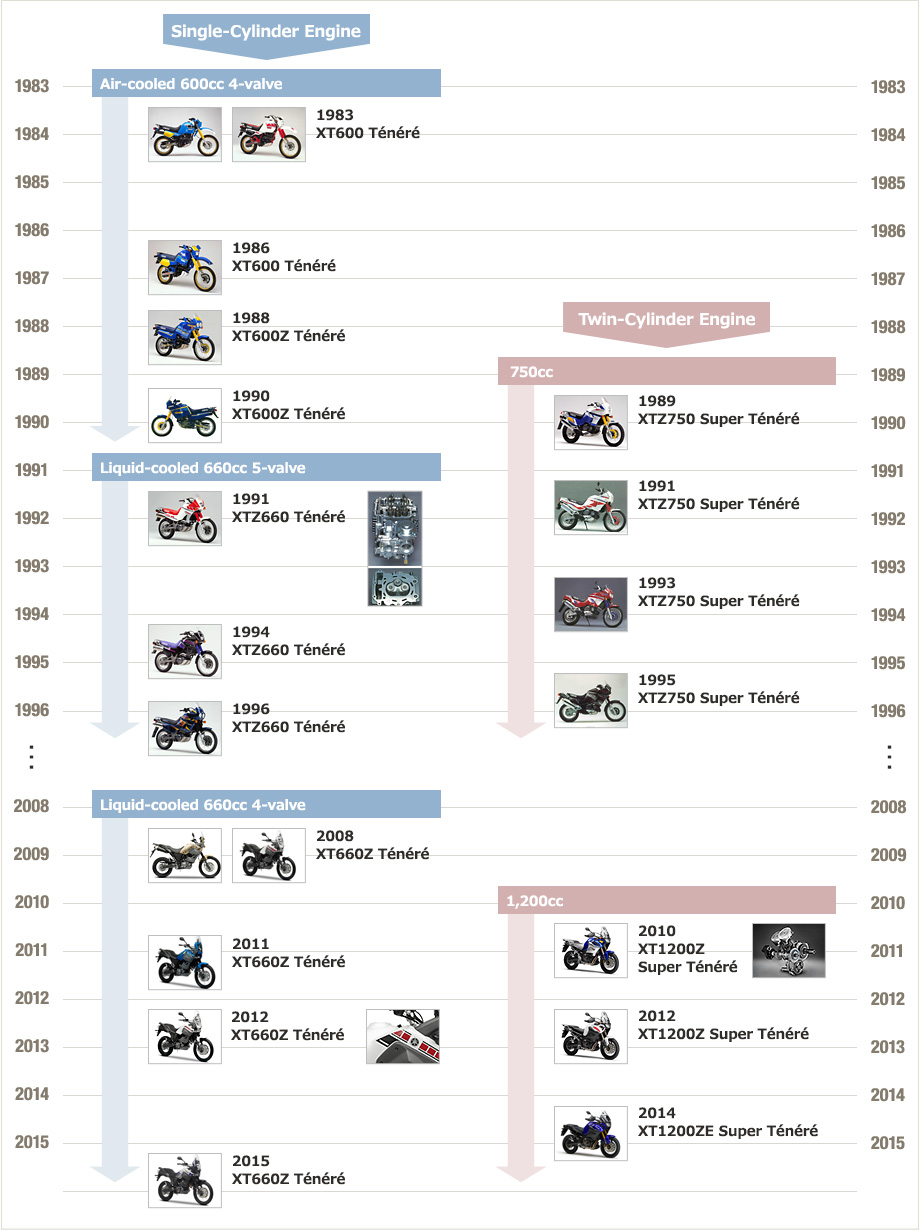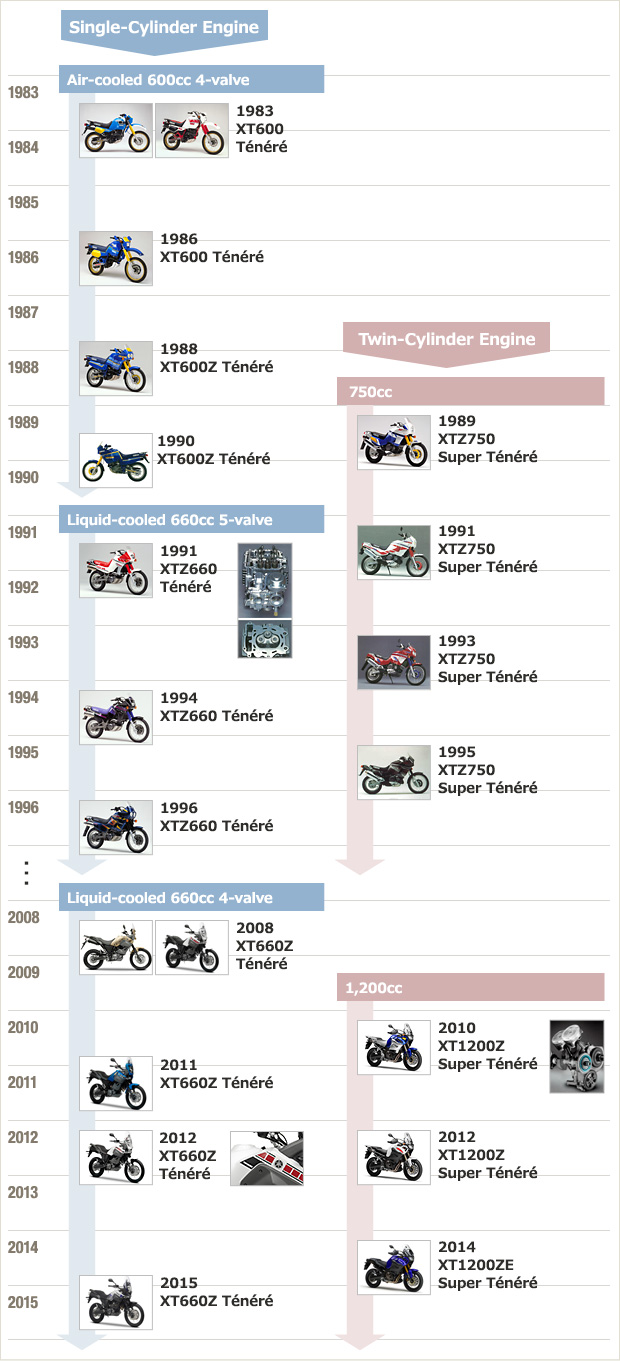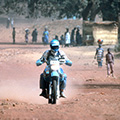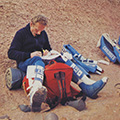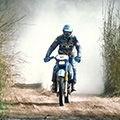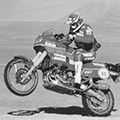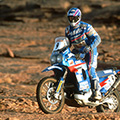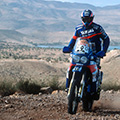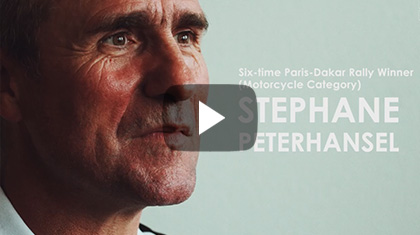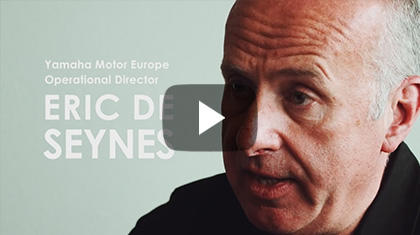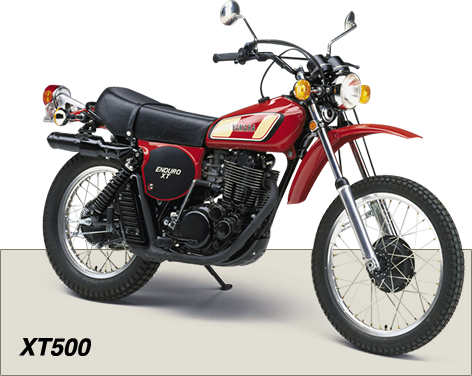
After pioneering the new “trail” bike category with the DT-1 and then firmly establishing itself as a leader in motocross with the Monocross suspension, Yamaha began development of two more epoch-making models for the United States’ now-booming off-road market: the TT500 enduro machine released in 1975 and the XT500 dual-purpose model released in 1976. Both of these 4-stroke big-singles catered to the needs of the fanatical off-road enthusiasts that enjoyed riding on the wild open terrain and deserts of the American West Coast. Their highly durable engines had strong torque, and their robust, lightweight chassis could handle the vibration of such a power unit. They became instant big-sellers as recreational bikes perfect for enjoying spirited riding through America’s wild open spaces on the weekends. The bikes also became the dominant machine in various types of enduro races and won competitions all over the country.
Meanwhile, in Europe the XT500 became an unexpectedly big hit for a use different from that in America: its stylish design was what won it a growing presence on the street. The combination of its torquey engine and a lightweight, slim chassis made it an all-rounder capable of being used for everyday errands as well as touring, making it a popular choice.
However, that wasn’t the only reason for its success. Thanks to the passion of one particular Frenchman—who would come to be known as “Mr. Yamaha” in the company—the XT500 would also serve as the spearhead for the development of another new category pioneered by Yamaha.
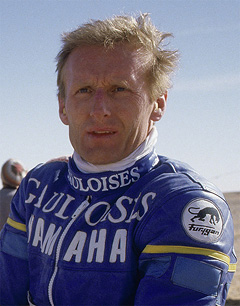 Olivier was always passionate about the Paris-Dakar Rally.
Olivier was always passionate about the Paris-Dakar Rally.His name was Jean-Claude Olivier. At the time, he was an employee of French Yamaha Motor product importer Sonauto, but he would later become the president of Yamaha Motor France S.A. and help pioneer what came to be called the “Adventure” category.
Olivier’s eyes would shine as he looked at the 500cc big-single and thought of the vast, unknown expanses of the African continent, saying, “The time has come for the motorcycle to be a vehicle for adventure.” He began by competing in the 1977 Rallye Côte d'Ivoire (Abidjan-Nice Rally) that ran some 10,000 km from the Republic of Côte d'Ivoire (Ivory Coast) capital of Abidjan to Nice in southern France. In this event he experienced the difficulties and the joys of adventure rally competition. (Also participating in this rally was the subsequent organizer of the Paris-Dakar Rally, Thierry Sabine.) Then in 1979, Olivier was joined by three other riders to race in the first Paris-Dakar Rally (also known as the Oasis Rally) as the “Sonauto Yamaha Team,” riding the XT500. At the time, the other automobile and motorcycle manufacturers showed little interest in this new competition, but Olivier was different. He described his decision to participate as a natural choice based on the product concept of the XT500.
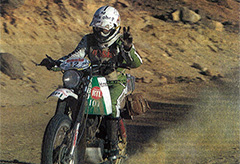 Cyril Neveu racing in the 1st Paris-Dakar
Cyril Neveu racing in the 1st Paris-DakarIn this first holding of the Paris-Dakar, automobiles and motorcycles didn’t have separate categories and 2-wheelers and 4-wheelers raced for the overall win. Riders Cyril Neveu and Gilles Comte outran the numerous Range Rovers, Renaults and other off-road cars to a 1-2 finish on the Yamaha XT500, respectively. In the second Paris-Dakar the following year, Neveu won again and XT500 riders swept the top four places of the race. What’s more, of the 25 motorcycles that finished the Rally that year, 11 were XT500s—more than any other brand.
In this way, the XT500’s stylish design destined for California also won the hearts of many fans in France and other European countries by sparking in them the desire for “Adventure.”
 The Sonauto Yamaha Team led by Jean-Claude Olivier standing with their XT500s (1979)
The Sonauto Yamaha Team led by Jean-Claude Olivier standing with their XT500s (1979)From its third running the following year in 1981, the Paris-Dakar became an FIA- and FIM-sanctioned race and both automobile and motorcycle factory teams quickly began joining the competition. Among the most ambitious participants were the BMW teams, and the XT500 riders now found themselves eating the dust of the BMW bikes that were powered by a “flat engine” (engine with horizontally-opposed pistons). The next year, Yamaha updated the XT500 by releasing the XT550. It was equipped with the Yamaha-exclusive YDIS (Yamaha Dual Intake System) device, but as the average speeds of the Paris-Dakar grew faster, it was a struggle to keep the bike competitive.
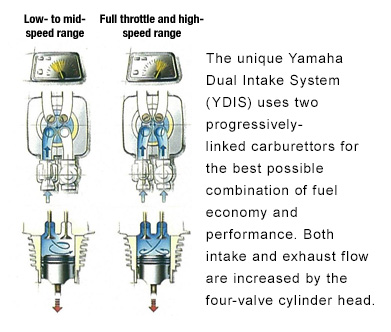
This prompted Olivier and Sonauto to request Yamaha Motor in Japan to further develop the XT production models for new levels of off-road performance and equipment specifically designed for full-fledged rally competition. Inspired by the passion and determination from France, the development team at Yamaha headquarters set to work. The result of their efforts was the XT600 Ténéré. The bike boasted a 600cc engine that retained the YDIS, a big 30-liter fuel tank, the first front disc brake ever on a Yamaha off-road model, a bell-crank Monocross suspension, an aluminum swingarm and more. The XT600 Ténéré was developed concurrently with the TT600 enduro model for the North American market and had a very high level of reliability. When it was first unveiled at the Paris Motorcycle Show in the autumn of 1982, the XT600 Ténéré sparked a new movement that would spread worldwide.
After its official release, the Ténéré not only became the natural choice of numerous Paris-Dakar racers but also the choice of many general motorcyclists who admired the adventure that the Paris-Dakar symbolized. The Ténéré was the machine that best embodied their dreams and would ignite a worldwide boom in machines styled after those competing in the Paris-Dakar.
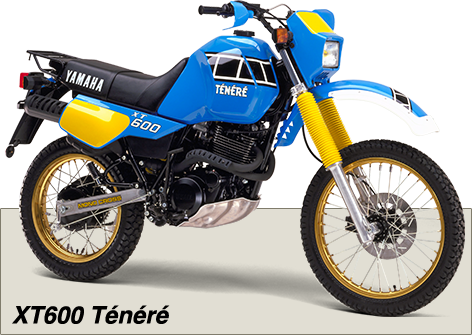
As a close observer of the events of those times, Yamaha Motor France’s current president Eric de Seynes recalls, “When we got the Ténéré 600, it was a fantastic success on the market. Really, it was fantastic; sales-wise, it was a big success.” In the ten years following its release, 61,000 XT600 Ténéré bikes were sold in Europe and more than 20,000 were sold in France alone. Later, the model would evolve in 1991 into the XTZ660 Ténéré, featuring a five-valve 660cc single-cylinder engine, and adopted dual headlights in 1994.
While continuing to embody the dreams of so many riders, the famed Ténéré would eventually come to symbolize the “spirit of adventure” of the Yamaha brand.
The Adventure category that began with the arrival of the XT500 truly reached a new level of popularity with the launch of the Ténéré, and the category would grow into a whole new type of motorcycle culture.
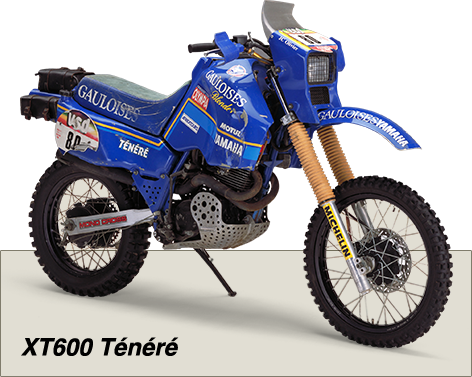
By establishing the Adventure category of motorcycles, Yamaha had enabled many riders to take part in the Paris-Dakar, but when it came to actual race results, Yamaha hadn’t gotten a win since the second one held in 1980.
Eventually, it was Jean-Claude Olivier’s determination to win the Paris-Dakar again that convinced the production model development department at Yamaha headquarters to take action. The XT600 Ténéré prepared for the 1985 Paris-Dakar bore the same name as the production model, but in fact, it was the first machine that Yamaha headquarters’ production model development department had built specifically for the Paris-Dakar. The fuel tank was a three-part design with a main tank and sub-tanks on the left and right, giving it a total capacity of 51 liters. With some modifications made by Sonauto, Olivier rode it to an impressive 2nd place finish. On top of that, 3rd and 4th place also went to XT600 Ténéré riders. However, with the Paris-Dakar getting faster every year, the victory continued to go to Yamaha’s rival and their horizontally-opposed twin-cylinder bike.
This prompted Olivier to attempt to increase the top speed of the machine for the 1986 Rally by using the 4-cylinder engine from the FZ750 sport bike for the machine, creating the FZ750 Ténéré. But with the disadvantage of its heavier weight, the best he could do was to finish in 12th place. Nonetheless, his unwavering determination to win the Rally inspired the race machine development department at Yamaha headquarters to take action.
 The FZ750 Ténéré ridden by Olivier in 1986
The FZ750 Ténéré ridden by Olivier in 1986
The next year in 1987, Yamaha’s race machine development department in Japan finally began working on a factory machine for the 1988 Rally. This was the “0W93” or “YZE750 Ténéré” machine powered by a liquid-cooled 750cc single-cylinder five-valve engine. Olivier also brought 22-year-old French enduro champion Stéphane Peterhansel into the factory team. Peterhansel reflected on the events of the time: “This race was my dream. It was not my dream to win this race; it was just a dream to do it. And I was really lucky, because one day [in the middle of 1987], Jean-Claude Olivier called me and he asked if I was interested in doing the Dakar, and I said for sure! This is my dream! I want to do this race!”
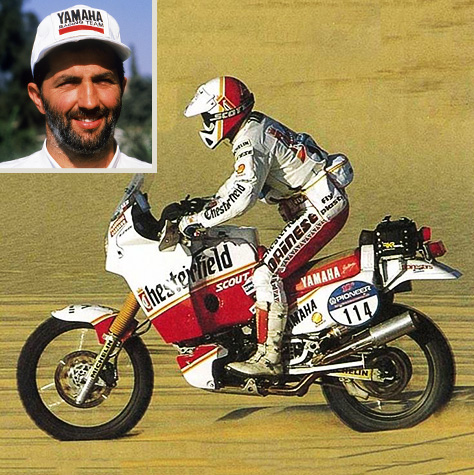 Riding the liquid-cooled single-cylinder 5-valve twin-plug YZE750 Ténéré (0W93), Franco Picco finished 2nd in 1988.
Riding the liquid-cooled single-cylinder 5-valve twin-plug YZE750 Ténéré (0W93), Franco Picco finished 2nd in 1988.
Peterhansel was present for the pre-race tests where the final adjustments were made to the 0W93 before eight machines were supplied to the Sonauto team, the Belgarda team and the Spanish Yamaha team for participation in the 1988 Paris-Dakar. In the race, however, Peterhansel went off-course at one point and lost precious ground, causing him to finish 18th overall. Meanwhile, Olivier took a fall and broke bones in his arm a week before the finish, but he raced on to finally finish 7th. Later, Peterhansel would comment about the tremendous willpower and determination Olivier had shown: “I remember when I did my first Dakar. [Mr. Olivier] was a rider; it was in ’88. I started with a good race, but in the middle of the race I did a big mistake so I was not ever able to get a good result. And I remember that Jean-Claude Olivier crashed and broke bones in his arm and he [still] tried to finish. But for me, it was not possible. I said with an arm broken, it’s not possible. But in the end, he finished the race. It was not easy but after that I said, Mr. Olivier is really a strong man, not only with his speed when riding but also [mentally] because to finish the Dakar like that with an arm broken, for me it was not possible. It was during my first Dakar so I was really impressed about his [ability]; he was really strong, never [gave up] and was always [pushing his physical limits].”
Among the 0W93 riders in that 1988 Paris-Dakar, it was the Belgarda team’s Franco Picco who had the best race. Until the last stages of the Rally, he was in a dead heat with Edi Orioli on a Honda NXR750, but was unable to catch his rival and finished 2nd. In the following year’s Rally, Picco rode well on the further-improved 0W94 factory machine but once again had to settle for 2nd place by a margin of 54 minutes. Although they were unable to prevent the Honda factory team from winning again, the knowhow gained from the 0W93 machine that Picco had ridden would be fed back into the development of the next Ténéré production model.
 Riding the liquid-cooled single-cylinder 5-valve twin-plug YZE750 Ténéré (0W93), Franco Picco finished 2nd in 1988.
Riding the liquid-cooled single-cylinder 5-valve twin-plug YZE750 Ténéré (0W93), Franco Picco finished 2nd in 1988.
It was December 1987. Around the time Yamaha’s first Paris-Dakar factory machine, the 0W93, arrived in Paris, the production model development department at Yamaha headquarters began creating the next-generation production model of the Ténéré series, the XTZ750 Super Ténéré. The development team was inspired by the aura of fascination and dreams the Ténéré models had come to hold for riders and they knew that Yamaha had to always be the leader of the Adventure category.
The concept was clear: provide an Adventure motorcycle that embodies the dream of entering the prestigious Paris-Dakar. They narrowed down the absolute requirements of such a model to four main points: 1) be comfortable to ride even after long hours in the saddle, 2) have high power to enable riding at high speeds, 3) have performance that inspires confidence in savannah and forest trail riding and 4) have the parts and functions needed for city riding. However, some of these were conflicting qualities. To guide them through the difficulties of achieving these objectives and define the model image, the team chose two key phrases:
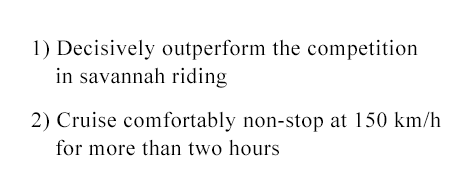
The first thing they did was decide the machine’s dimensions based on feedback from the 0W93 that Picco rode to a 2nd place finish in 1988. In particular, the 1,515 mm wheelbase they chose was a very important factor for ensuring handling stability in a big-displacement Adventure bike. A double cradle frame was chosen in order to accommodate the high-speed performance target for the bike.

For the new engine, the desire to maintain the good feeling of performance of the original single-cylinder Ténéré while enabling higher levels of power and speed, a 10-valve 750cc in-line twin with a 360° crank was chosen. The engine design also featured a downdraft intake, a built-in twin-shaft gear-driven balancer and dry-sump lubrication. Of course, as the father of the “Ténéré World,” Jean-Claude Olivier was involved in testing the prototype.
Then in the autumn of 1988, the new XTZ750 Super Ténéré was unveiled at the Paris Motorcycle Show.
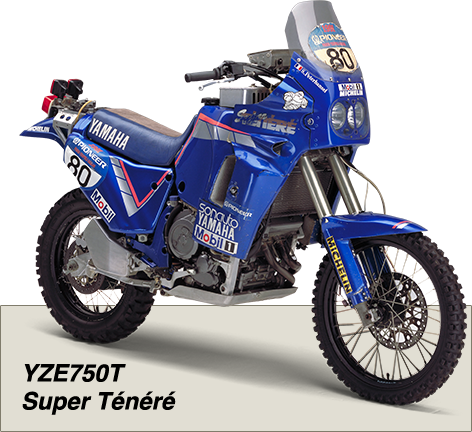 The YZE750T Super Ténéré that dominated the Paris-Dakar in 1991
The YZE750T Super Ténéré that dominated the Paris-Dakar in 1991Taking the newly developed XTZ750 Super Ténéré production model as a base model, efforts accelerated toward factory entry in the Paris-Dakar Rally. In 1990, the 802.5cc YZE750T Super Ténéré factory machine carried Carlos Mas to a 2nd place finish. Then in 1991, eight riders from the Sonauto and Italian teams entered the Rally on a further advanced version of it.
That year finally brought success; YZE750T Super Ténéré riders took every spot on the podium and brought Yamaha its first victory in ten years. It was the moment when the dedication and determination of Jean-Claude Olivier and the Yamaha development team to win the Rally again finally bore fruit.
The winner of the race that year, Peterhansel recalls the moment: “I remember at the podium, [Olivier] took my hand at the podium and he started to cry a little bit. It was really emotional and it was maybe the best feeling of my career [with six Dakar wins]. Since I joined Yamaha, he put his trust in me and told me to take my time, gave me lots of support and said he was sure I would win the Dakar. After four years, I won my first Dakar so for him, [he was right on target]. It was a relationship a little bit similar to a son and father.”
In 1994, the regulations for the race changed and limited participation to production models. Although that forced Yamaha to suspend its factory participation, it didn’t affect Olivier’s passion for the event. For privateer riders wanting to participate in the Rally, Yamaha Motor France released its own specially built production models designed specifically for the Dakar. They sold the required 15 units each of the twin-cylinder XTZ850R and single-cylinder XT660R, for a total of 30 units. At the time, the XTZ850R sold for about 140,000 francs (roughly 25,000 USD at the time). These machines continued to help privateers realize their dream of competing in the Paris-Dakar.
 Stephane Peterhansel won the Paris-Dakar for the fourth time in 1995.
Stephane Peterhansel won the Paris-Dakar for the fourth time in 1995.The following year, Peterhansel returned to the Paris-Dakar Rally as a factory rider on a machine based on the XTZ850R and won his fourth victory in the 1995 Rally. In 1996, Edi Orioli won the Rally with Yamaha, and in 1997 and 1998, Peterhansel took consecutive wins riding the XTZ850TRX featuring a 270° crank that provided excellent traction in the desert sands. In doing so, Peterhansel achieved an unprecedented record of six wins in the motorcycle division of the Paris-Dakar. These achievements also contributed to Yamaha winning 9 of the 19 Paris-Dakar rallies run up to 1998—the most of any motorcycle manufacturer—before ending its factory participation in the Rally.
The knowhow and technology Yamaha gained in its Paris-Dakar Rally challenge were later applied to the XTZ660 Ténéré and XTZ1200 Super Ténéré models that eventually established the Ténéré brand name of Yamaha models. However, these technical assets were not limited to Adventure bikes; they also found use in road-going sport bikes and in developing new model categories.
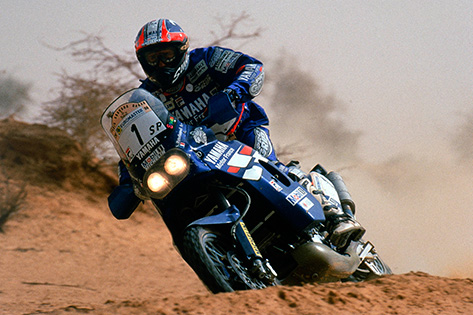 In 1998, Stephane Peterhansel took his sixth Paris-Dakar win aboard the XTZ850TRX.
In 1998, Stephane Peterhansel took his sixth Paris-Dakar win aboard the XTZ850TRX.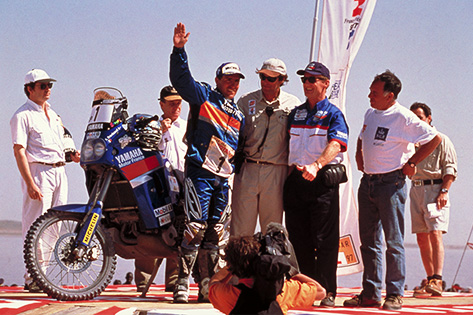
The word “ténéré” in the Tuareg languages of North Africa means “desert” or “solitude.” Yamaha’s challenge in the Paris-Dakar waged hand-in-hand with passionate adventurers determined to conquer this barren “desert of deserts” was one worthy of the manufacturer that pioneered off-road machines from the outset. No single person symbolizes that challenge better than the late Jean-Claude Olivier, the man who served as the unifying and driving force in the Dakar challenge throughout those years.
Today, his numerous achievements and indomitable Spirit of Challenge stand not only as a model for Yamaha Motor France but also for every member of the global Yamaha family to look up to with pride.
(click for full-size images)
